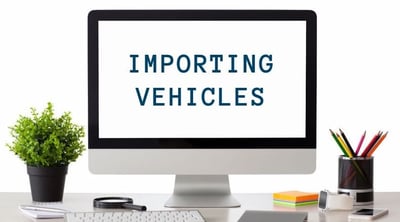Single Window Initiative (SWI): Survival Guide for importing vehicles
The new SWI landscape
The Single Window Initiative means several changes for importers:
- how you need to submit documentation is in flux;
- when that documentation is needed has changed; and
- which documentation is required is also shifting.

Our goal is to help you understand what is expected for the new “how, when, and what” of SWI requirements relating to the items you ship. These updates guide importers through specific commodities or categories of commodities, and the Participating Government Agencies (PGAs) that are affected.
How, when, and what
- Single Window Initiative requires all import documentation to be prepared and submitted before the shipment reaches customs.
- SWI is a new way of submitting documentation. All docs will be submitted using the Integrated Import Declaration (IID). Some of the requirements for how you submit are changing. For example: some documents that needed to be faxed now require an uploaded electronic image or just the document number.
- There may be changes to which documents are required under SWI.
- The launch date of SWI is still unknown, but it’s time to get proactive and adjust your workflow to ensure paperwork is ready before you ship.
Why importers need to know
Under the new SWI, it’s important that you understand which Participating Government Agencies (PGAs) are regulating your products. Some products are regulated by multiple PGAs, and the PGAs regulating your products may have changed under SWI. Additionally, each PGA and the CBSA can issue penalties for incorrect and missing documents. Understanding what information and documentation is needed for clearance will make the clearance process into Canada smoother and more efficient.
Importing vehicles under SWI
This month, we’ll guide you through importing vehicles under the new Single Window Initiative, which is regulated by:
Transport Canada (TC) - Registrar of Imported Vehicles (RIV)
Environment and Climate Change Canada (ECCC) - Vehicle and Engine Emissions Program
The requirements for TC and ECCC have not changed moving into SWI. They have changed the way these requirements (data elements) are reported.
Before SWI, a broker could not submit any product regulated by Registrar of Importing Vehicles electronically. Paper entries were manually submitted to the port of crossing along with the Form 1. Form 1s were stamped and given to the carrier along with a copy of the release of the shipment.
Now with SWI, the Form 1 data elements are transmitted electronically along with the shipment for approval from RIV and release from Customs.
For a great overview, read through Cole's tips for importing vehicles.
Before importing a vehicle
Before importing a vehicle into Canada please visit the Transport Canada – Registrar of Imported Vehicles (RIV) website for information on vehicle admissibility.
All vehicles are required to report information to TC-RIV, but that does not mean they are required to pay additional RIV fees. Based on provincial requirements, some work vehicles are also required to report.
The specific Transport Canada program the vehicle falls under will dictate if you are required to go through the Transport Canada – Registrar of Imported Vehicles (RIV) program and pay the associated fee, or not.
Here’s a list of the Transport Canada vehicle programs to determine which applies to your vehicle:
- Federal Motor Vehicle Safety Standard: all used vehicles are required to go through the RIV program.
- Federal Motor Vehicle Safety Standard Case-By-Case: one time pre-approval from Transport Canada, a case number is required.
- Canadian Motor Vehicle Safety Standard Appendix F: pre-clearance program for Canadian commercial importers who import over 2500 vehicles per year.
- Canadian Motor Vehicle Safety Standard Appendix G: only new vehicles imported directly from the manufacturer.
- Returning Vehicles: vehicles that are registered in Canada returning to the country.
- Age Exemption Vehicles: vehicles more than 15 years old.
- Unregulated Vehicles: vehicles brought in temporarily by visitors and/or workers.
- Canadian Motor Vehicle Safety Standard Appendix Case-By-Case: one time pre-approval from Transport Canada, a case number is required.
- Vehicles For Parts.
Transport Canada requirements for vehicles
1. Party information
All Transport Canada shipments require specific party information:
- Name, address, other contact information
- Vendor
- Manufacturer
- Registering party
- Assembler: final stage assembler
2. Documents
Depending on the type of Transport Canada program used, you may be required to provide certain documents, such as:
- Vehicle title
- Manufacturer letter of compliance
- Racing sanctioning body letter
- Vehicle registration (for Returning Vehicles program)
- Case-By-Case authorization (for Case-By-Case programs)
3. Vehicle Class
For example: passenger car, motorcycle, trailer, snowmobile, specially designed work vehicle, etc.
4. Vehicle identification number
The 17-digit VIN must be provided.
5. Data elements
Other required data elements include; make and model of vehicle, model year, manufacture/production date, chassis make, model, and year, chassis manufacturer if different from the vehicle, vehicle condition (Used Vehicles Program), mileage/odometer reading (if country of origin in Mexico), and title status (rebuilt, salvage, scrap, clean).
Environment and Climate Change Canada (ECCC) - Vehicle and Engine Emissions Program requirements
Along with Transport Canada, any vehicle that has an engine must report some information on that engine to determine if it complies with ECCC’s emissions requirements.
1. Data elements
- Make and model of vehicle
- Make and model of engine
- Model year of engine
- Engine manufacturer name
- Vehicle identification number (VIN)
- Engine Identification number
- Name of engine family
- Test group name
- Engine power rating
- Make and model of machine (Off-Road compression)
- Model Year of Machine (Off-Road compression)
2. Vehicle Class
3. Engine Class
4. Affirmation of statement compliance
- National Emissions Mark
- EPA Certified or considered equivalent to EPA Certified
- Canada Unique Vehicles, Engines
- Incomplete Vehicles or Engines
- EPA Certified and sold concurrently in Canada and the U.S.
- Transition and sold concurrently in Canada and the U.S.
- Canada Unique Engines, Incomplete Engines
Once your vehicle is successfully imported
All information about this import will be reported to all provincial and territorial licensing offices via the Interprovincial Record Exchange (IRE).
For vehicles not required to go through the Registrar of Imported Vehicles program (but still required to report to RIV), you will need the following to register your vehicle:
- Canada Customs B3 to show GST being paid at the border.
- Registrar of Imported Vehicles confirmation email of border crossing.
For vehicles required to go through the Registrar of Imported Vehicles Program there are steps need to be done BEFORE you can take your vehicle in for federal and provincial inspections:
- You will receive the Registrar of Imported Vehicles Form 1 from the border officer if you are declaring your vehicle at customs.
- Make the RIV payment online.
- Print off the Registrar of Imported Vehicles Form 2 and enter the case number.
- Print two copies of the Form 2, and take the RIV Form 1 with you to any Canadian Tire facility for the federal inspection.
- Bring your stamped RIV Form 1 and Form 2 to any registration office to register your vehicle.
For SWI, being proactive is your best strategy—gather all your information and documentation as far in advance as possible. Importers who know the requirements for the products they’re importing, and understand the new processes under SWI, will have a much smoother import experience.
As you adjust to the new requirements and workflow of the Single Window Initiative, we're here to help. Our customs team is ready to help you understand the SWI and its new requirements for your commodities—contact us today!
SWI. It's what we do.

Latest Articles
- 7 ways Canadian importers reduce risk when ordering overseas
- Watch out for these extra charges on your freight bill
- Key differences between duty drawbacks and duty refunds for importers
- Mitigating container shortages and rising shipping prices for ocean imports
- How Canadian importers benefit from end use tariff codes and conditional relief
